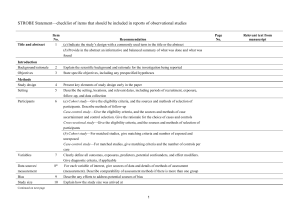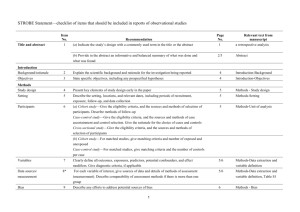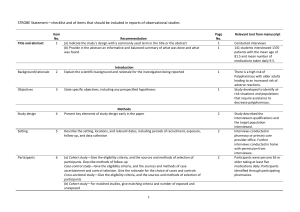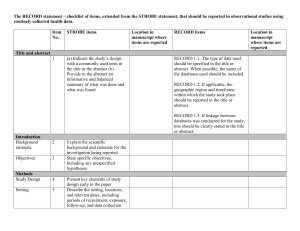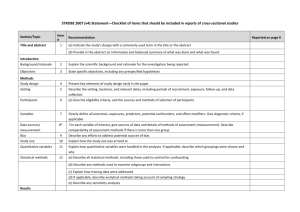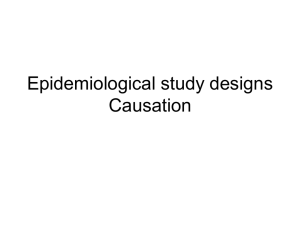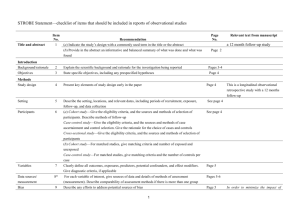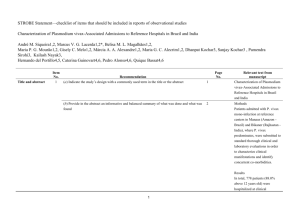file - BioMed Central
advertisement
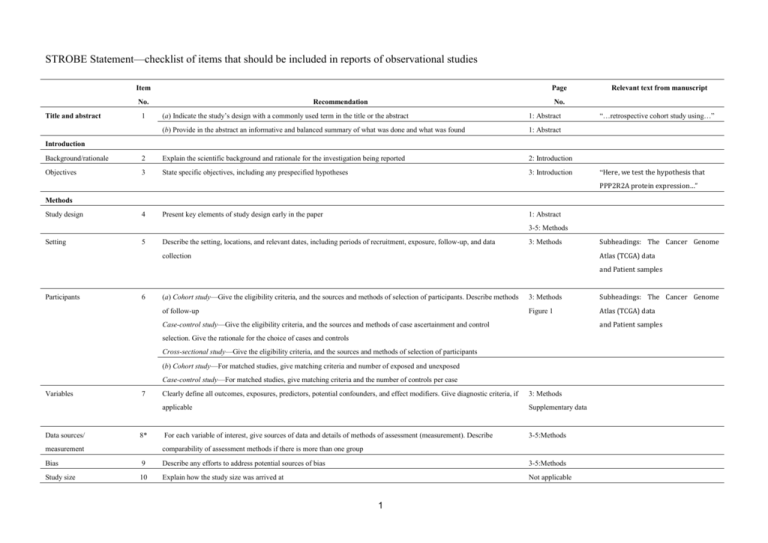
STROBE Statement—checklist of items that should be included in reports of observational studies Item Page No. Title and abstract 1 Recommendation Relevant text from manuscript No. (a) Indicate the study’s design with a commonly used term in the title or the abstract 1: Abstract (b) Provide in the abstract an informative and balanced summary of what was done and what was found 1: Abstract “…retrospective cohort study using…” Introduction Background/rationale 2 Explain the scientific background and rationale for the investigation being reported 2: Introduction Objectives 3 State specific objectives, including any prespecified hypotheses 3: Introduction “Here, we test the hypothesis that PPP2R2A protein expression…” Methods Study design 4 Present key elements of study design early in the paper 1: Abstract 3-5: Methods Setting 5 Describe the setting, locations, and relevant dates, including periods of recruitment, exposure, follow-up, and data 3: Methods Subheadings: The Cancer Genome Atlas (TCGA) data collection and Patient samples Participants 6 (a) Cohort study—Give the eligibility criteria, and the sources and methods of selection of participants. Describe methods 3: Methods Subheadings: The Cancer Genome of follow-up Figure 1 Atlas (TCGA) data and Patient samples Case-control study—Give the eligibility criteria, and the sources and methods of case ascertainment and control selection. Give the rationale for the choice of cases and controls Cross-sectional study—Give the eligibility criteria, and the sources and methods of selection of participants (b) Cohort study—For matched studies, give matching criteria and number of exposed and unexposed Case-control study—For matched studies, give matching criteria and the number of controls per case Variables Data sources/ 7 8* measurement Clearly define all outcomes, exposures, predictors, potential confounders, and effect modifiers. Give diagnostic criteria, if 3: Methods applicable Supplementary data For each variable of interest, give sources of data and details of methods of assessment (measurement). Describe 3-5:Methods comparability of assessment methods if there is more than one group Bias 9 Describe any efforts to address potential sources of bias 3-5:Methods Study size 10 Explain how the study size was arrived at Not applicable 1 Quantitative 11 variables ““Statistical 12 Explain how quantitative variables were handled in the analyses. If applicable, describe which groupings were chosen and 4: Methods Subheading: why Supplementary data PPP2R2A (B55α) scoring (a) Describe all statistical methods, including those used to control for confounding 5: Methods Subheading: Supplementary data Statistical Analysis 5: Methods Subheading: Supplementary data Statistical Analysis Figure 1 “Subjects with missing values for 4: Methods survival and PPP2R2A (B55α) 8: Results expression in both cohorts were Supplementary data excluded from the analyses.” 4: Methods “Women in whom the envisaged methods (b) Describe any methods used to examine subgroups and interactions (c) Explain how missing data were addressed (d) Cohort study—If applicable, explain how loss to follow-up was addressed Case-control study—If applicable, explain how matching of cases and controls was addressed end-point was not reached were Cross-sectional study—If applicable, describe analytical methods taking account of sampling strategy censored as of the last follow-up date.” (e) Describe any sensitivity analyses 6: Results “We performed a sensitivity analysis that supports the assumption that disease-specific events occurred earlier (more details in SD Figure 1).” Results Participants 13* (a) Report numbers of individuals at each stage of study—eg numbers potentially eligible, examined for eligibility, Figure 1 confirmed eligible, included in the study, completing follow-up, and analysed Descriptive data 14* (b) Give reasons for non-participation at each stage Figure 1 (c) Consider use of a flow diagram Figure 1 (a) Give characteristics of study participants (eg demographic, clinical, social) and information on exposures and potential Table 1 confounders Outcome data 15* (b) Indicate number of participants with missing data for each variable of interest Table 1 (c) Cohort study—Summarise follow-up time (eg, average and total amount) Table 1 Cohort study—Report numbers of outcome events or summary measures over time Table 1 6-8: Results 2 Case-control study—Report numbers in each exposure category, or summary measures of exposure Cross-sectional study—Report numbers of outcome events or summary measures Main results 16 (a) Give unadjusted estimates and, if applicable, confounder-adjusted estimates and their precision (eg, 95% confidence Table 2 interval). Make clear which confounders were adjusted for and why they were included 6-8: Results (b) Report category boundaries when continuous variables were categorized 4-5: Methods Detailed description of Supplementary data. categorization methods in supplementary data. (c) If relevant, consider translating estimates of relative risk into absolute risk for a meaningful time period Other analyses Not applicable 17 Report other analyses done—eg analyses of subgroups and interactions, and sensitivity analyses 6-8: Results Key results 18 Summarise key results with reference to study objectives 8-9:Discussion Limitations 19 Discuss limitations of the study, taking into account sources of potential bias or imprecision. Discuss both direction and magnitude 9: Discussion Discussion limitations remain.” of any potential bias Interpretation 20 “However, some important Give a cautious overall interpretation of results considering objectives, limitations, multiplicity of analyses, results from similar 8-10: Discussion studies, and other relevant evidence Generalisability 21 Discuss the generalisability (external validity) of the study results 9: Discussion 22 Give the source of funding and the role of the funders for the present study and, if applicable, for the original study on which the 11: Acknowledgements Other information Funding present article is based *Give information separately for cases and controls in case-control studies and, if applicable, for exposed and unexposed groups in cohort and cross-sectional studies. Note: An Explanation and Elaboration article discusses each checklist item and gives methodological background and published examples of transparent reporting. The STROBE checklist is best used in conjunction with this article (freely available on the Web sites of PLoS Medicine at http://www.plosmedicine.org/, Annals of Internal Medicine at http://www.annals.org/, and Epidemiology at http://www.epidem.com/). Information on the STROBE Initiative is available at www.strobe-statement.org. 3
